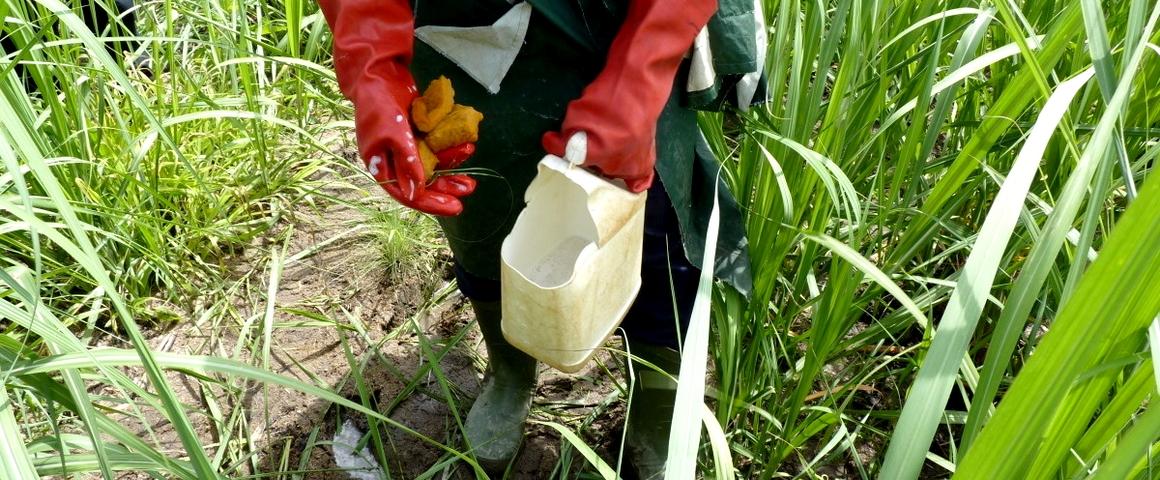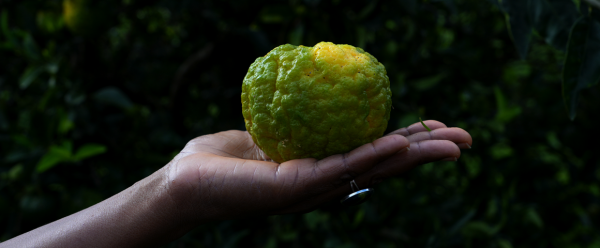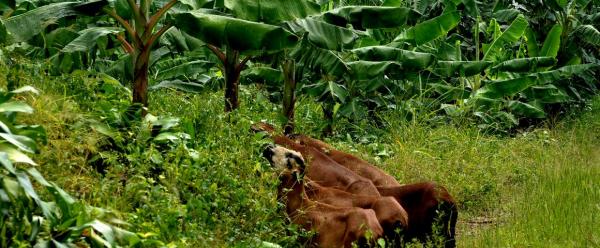Science at work 19 December 2025
- Home
- CIRAD news
- News
- Agroecological transitions for sugarcane cultivation
Sugarcane in the age of agroecology

Applying herbicide on weeds using a sponge so as not to touch the sugarcane leaves © P. Marnotte, CIRAD
Sugar, rum, fertilizer, biofuel, etc, etc: there are many products that can be made from sugarcane. In the light of growing global demand, cultivation is being intensified, yields are rising and new land is being planted.
With just under three million tonnes of sugarcane produced annually, France is a lightweight compared to Brazil (715 million tonnes in 2021) or India (405 million). On a scientific and agronomic level, however, France is ahead of the rest, by virtue of its more virtuous, environmentally friendly agricultural practices. The watchword is agroecology, in other words methods centring on reducing chemical use, restoring biodiversity and maintaining soil health.
Sustainable, agroecological sugarcane in the French overseas regions
"In Réunion, for instance, sugarcane covers half the island's usable agricultural land. It plays a vital role in the local economy", says CIRAD Sugarcane Value Chain Correspondent Christophe Poser. He is a member of a team of scientists who have been working for decades with sugarcane producers and local players. Developing alternatives to herbicides is the absolute priority in Réunion, Guadeloupe and Martinique, where CIRAD and its partners are helping to build a "zero pesticide" ambition.
"The situation in the French overseas regions is favourable in terms of an agroecological transition", the researcher says. "Sugarcane is already grown in a relatively virtuous way there, with reasonable chemical input use and without burning before harvest. Progress is being made as regards the availability of suitable sugarcane varieties and biological control, and also innovative cropping systems. Beneficials are also encouraged, notably by introducing host plants." While producers are convinced of the need to take the agroecology road, they do not yet have all the necessary solutions at their disposal. According to Christophe Poser, there is still substantial collective work to be done on developing techniques and assessing impact. Lastly, "for the transition to be possible, farmers need to see financial returns on their efforts".
Varietal improvement, better pest and disease knowledge, new farming practices including digital tools, economically viable innovations, value chain organization, etc: research is helping to broaden the scope of possibilities. In ultraperipheral regions, that research has supported from the European Union, which is keen to foster more environmentally friendly agriculture.
Agroecology for small African farms
Several solutions developed in the French overseas regions could be rolled out to Africa, according to Christophe Poser. "The continent is facing growing demand for sugar, due to population growth. In the light of changing markets and of the impacts of climate change, agroecology could tempt small-scale producers. It protects soil health, enabling it to be used for long periods, diversifies the range of sources of income and reduces reliance on inputs. In short, the benefits are clear."
Techniques exist, but have not necessarily been taken on board as yet. CIRAD is therefore counting on the human and social sciences to pinpoint the obstacles to the agroecological transition in these regions, backed by a network of local partners in the fields of research, training and agriculture.
Sugarcane producing countries frequently exchange young shoot cuttings from different varieties. It takes ten tonnes of cuttings to plant one hectare of sugarcane.
These exchanges allow producers to test, adapt and improve their plantations. However, cuttings may carry diseases, insects or fungi. They must therefore spend some time in quarantine.
To help its partners to protect themselves, CIRAD allows them to use its quarantine facility in Montpellier, which also contains several varieties adapted to climate change. The aim is to improve access to biodiversity, which is key to enabling producers to adapt.



























